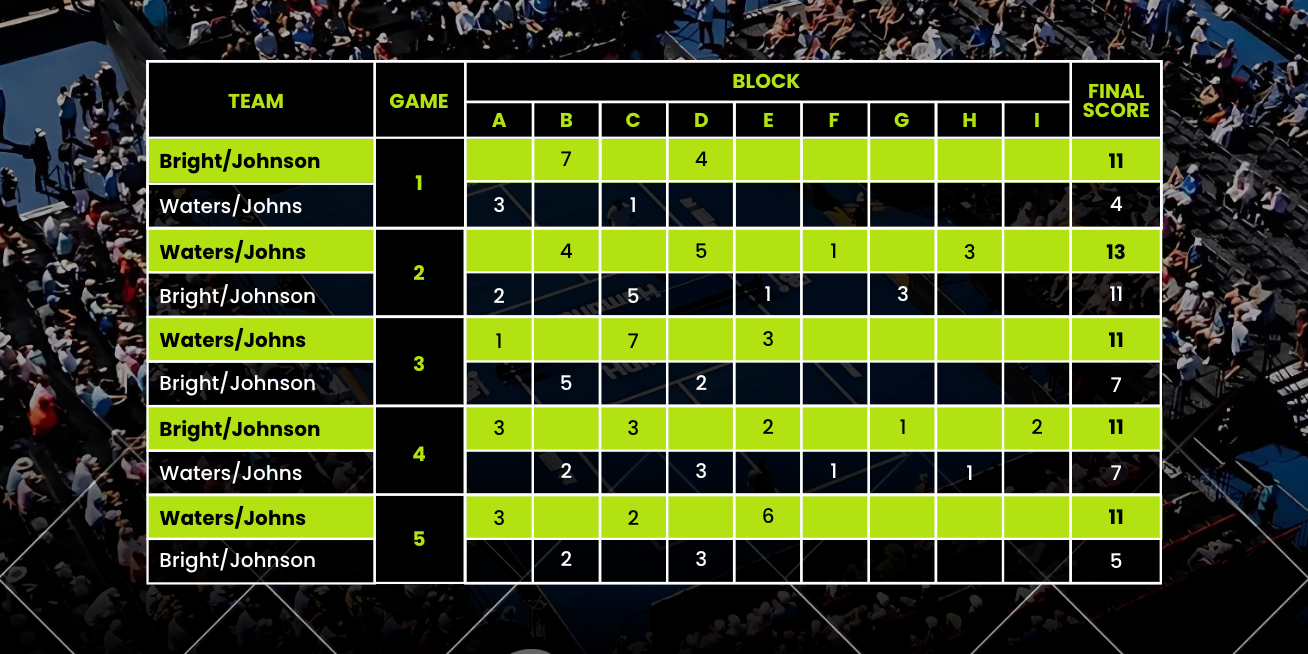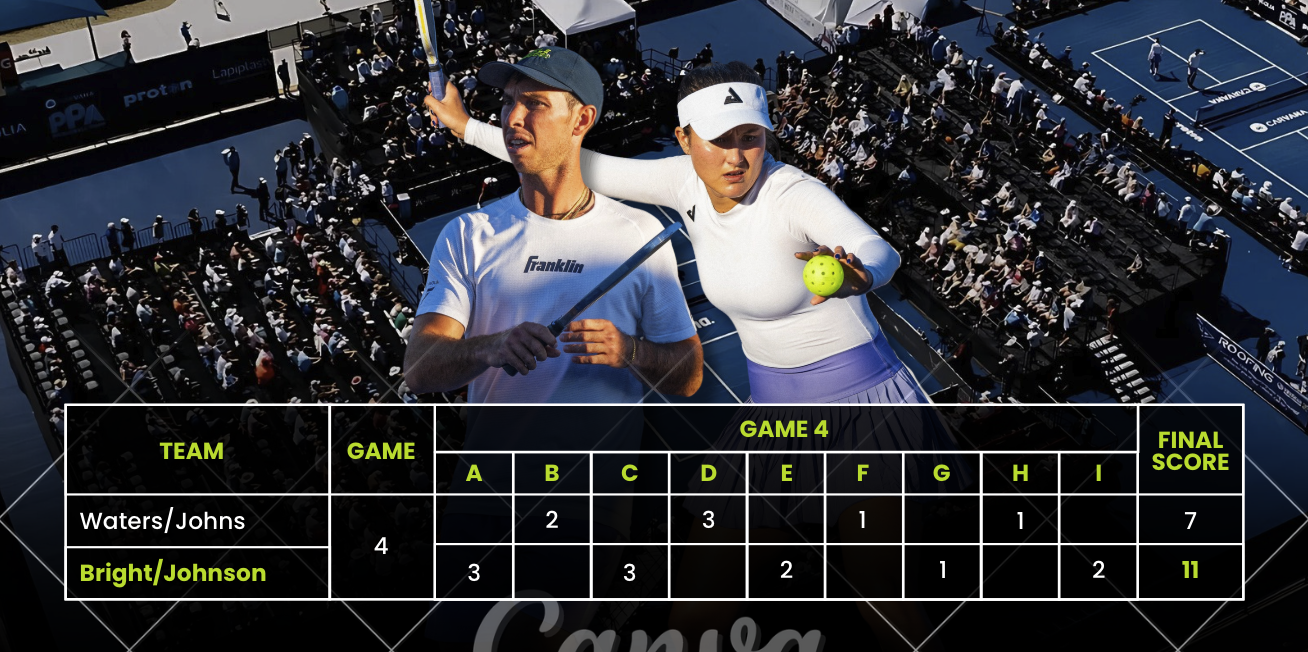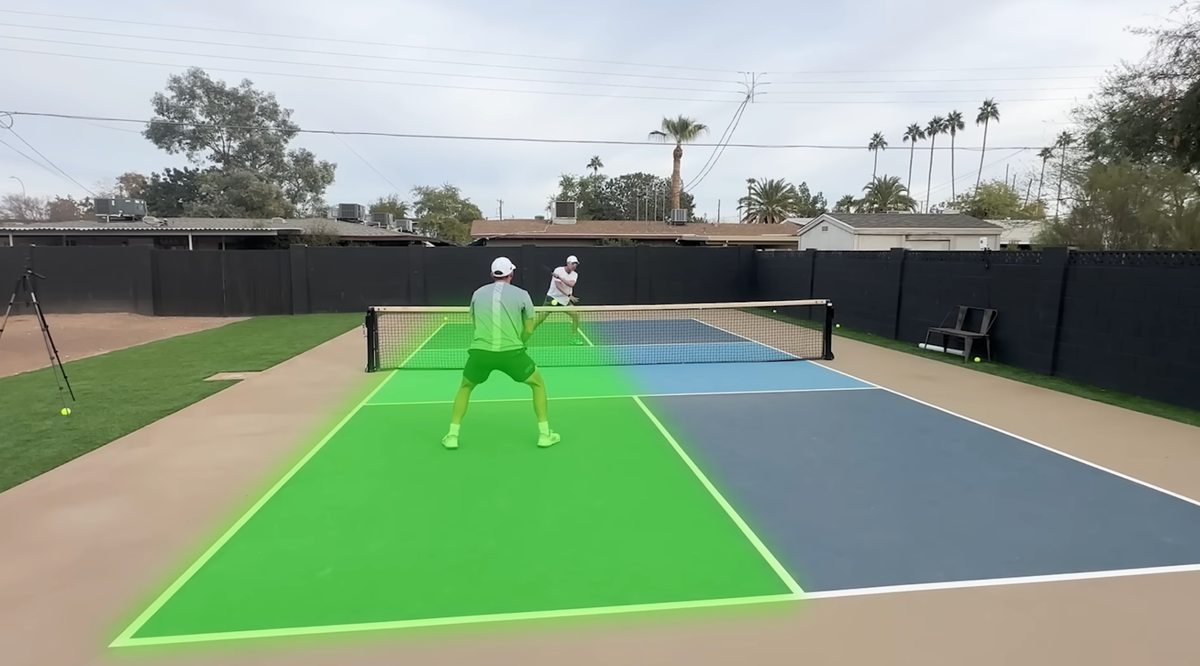Rather than a static line score, block scoring brings a game or match to life by visualizing the momentum swings along the way.
In pickleball, the final score rarely tells the whole story of a game or match. For your consideration: It's time to discuss "Block Scoring."
In traditional pickleball scoring, we know the basics: the first team to 11 points (with a 2-point margin) wins. The match is typically recorded using line scorekeeping — a simple list of final scores, game by game.
But what if there was a way to see how a game was won — not just the final tally?
Introducing: block scoring, a fresh take on documenting the story behind the score.
What Is Block scoring?
Block scoring tracks points in "blocks" — consecutive streaks of points earned by a team — instead of just listing the final score.
Each block is labeled alphabetically (A, B, C...) and alternates based on which team was scoring.
In short, instead of saying "Team A won 11–5," block scoring might show:
- Block A: Team A scores 4
- Block B: Team B scores 2
- Block C: Team A scores 3
- Block D: Team B scores 1
- Block E: Team A scores 4 to win the game
That’s a 5-block game, and it already tells you more than a simple line score.
A Simple Example: One Game
Let’s start with a basic single-game match: Anna Bright and JW Johnson vs. Anna Leigh Waters and Ben Johns in the finals at the PPA Cape Coral Open.
In game 2, Waters/Johns won 13-11. It was a great game, but the score alone doesn't tell the full story.
However, if we block out the scoring, you'd see this:

Block score:
- A: Bright/Johnson – 2
- B: Waters/Johns – 4
- C: Bright/Johnson – 5
- D: Waters/Johns – 5
- E: Bright/Johnson – 1
- F: Waters/Johns – 1
- G: Bright/Johnson – 3
- G: Waters/Johns – 3
Final Score: Waters/Johns 13, Bright/Johnson 11
This shows an incredibly close game with momentum swings throughout. In fact, if not for a strong start from Waters/Johns, this one could have easily gone the other way.
A Deeper Dive: Full Match Breakdown
Let’s now look at the full match.
Compared to a single game block score (above), the score of a full match tells a much more interesting story when laid out block score style.

- Game 1: Bright/Johnson open with a 7-point streak
- Game 2: Waters/Johns and Bright/Johnson trade long streaks — a true battle
- Game 3: Waters/Johns go on a 7-point run to take control
- Game 5: Waters/Johns close the match with a dominant 6-point final block
This was a five-game slug-fest with lots of lead changes and momentum swings.
When Games Get Wild: Close Contests vs Blowouts
Block scoring shines in two scenarios:
- Blowouts – A single 6- or 7-point block can seal the game early (like Game 1, above) or late (like Game 5).
- Back-and-forth battles – Alternating blocks show momentum swings that the final score can’t.
Compare:
- A lopsided game (11–3) might only need 2–3 blocks.
- A tight game (15–13) could require 10+ blocks, especially with frequent momentum changes.

Is 'Block Scoring' New?
Block-style breakdowns exist in some form across other sports. For instance:
- In volleyball, analysts track point runs.
- In tennis, “games won in a row” is sometimes noted.
- In wrestling, scoring breakdowns are grouped by action.
- In baseball, we can see an inning-by-inning report to see where the game was won/lost, not just that the game was won or lost.
But this particular block scoring format is new to pickleball — and possibly unique in the way it visualizes momentum. It's designed to give fans, analysts, and players a clearer window into how games unfold.
Gabriel Tardio Listened to His Mom and Ended Up with Two PPA Gold Medals
A little motherly advice turned into a double-gold weekend for Gabriel Tardio at the PPA Veolia North Carolina Open.
 The Dink PickleballAlina Leontarakis
The Dink PickleballAlina Leontarakis

Pros and Cons of Block Scoring for Pickleball
Of course, just because it's our idea, doesn't mean it's a good one. Let's examine some pros and cons.
Pros:
- Captures game flow and scoring momentum
- Highly visual
- Great for storytelling and analysis
- Useful for broadcasters, coaches, and stats fans
- Easy to implement for pro matches
Cons:
- Not intuitive to the untrained eye
- More complex to read at a glance
- Takes up more space — especially in long games
- May not be practical for casual or recreational play
Who’s It For?
Block scoring may not replace line scoring, but it adds a layer of depth — perfect for:
- TV broadcasts
- Coaching breakdowns
- Fan engagement
- Match recaps on social or in newsletters
For the pickleball fan who watches live broadcasts or match replays, on-screen displays of the block score during and, particularly, after a game would deliver a high-level perspective of the game’s dynamics, akin to the line score used in televised baseball games.
Pickleball is a game of momentum—block scoring helps bring that to life.
Example: Line Scoring vs. Block Scoring
Drag the line left and right to see the difference between a hypothetical set of match scores and a block score for one game.
Anuncie Aqui / Advertise Here
Sua marca para o mundo Pickleball! / Your brand for the Pickleball world!

 English
English  Spanish
Spanish  Portuguese
Portuguese  German
German  Italian
Italian  Japanese
Japanese  French
French  Polish
Polish  Russian
Russian  Netherlands
Netherlands  Hungarian
Hungarian  Turkish
Turkish  Videos
Videos 








 English (US) ·
English (US) ·  Portuguese (BR) ·
Portuguese (BR) ·